Thoroughly analyzing TS Inter 2nd Year Physics Model Papers and TS Inter 2nd Year Physics Question Paper March 2019 helps students identify their strengths and weaknesses.
TS Inter 2nd Year Physics Question Paper March 2019
Time: 3 Hours
Maximum Marks: 60
Section – A (10 × 2 = 20)
Note :
- Answer all questions.
- Each question carries two marks.
- All are Very Short Answer Type Questions.
Question 1.
Define Modulation. Why is it necessary ?
Answer:
Modulation: The process of combining low frequency audio signal with high frequency carrier wave is called modulation.
Necessary: Low frequency signals cannot transmit directly. To reduce size of the antenna and to avoid mixing up of signal from different transmitters modulation is necessary.
Question 2.
What focal length should the reading spectacles have for a person for whom the least distance of vision is 50 cm ? (The distance of Normal vision is 25 cm.)
Answer:
The distance of normal vision is 25 cm.
So, if a book is at v = -25 cm. Its image should be formed at v = -50 cm.
∴ \(\frac{1}{\mathrm{f}}\) = \(\frac{1}{\mathrm{v}}\) – \(\frac{1}{\mathrm{u}} \)
⇒ \(\frac{1}{\mathrm{f}}\) = \(\frac{1}{-50}\) – \(\frac{1}{-25}\) = \(\frac{1}{50}\)
⇒ f = + 50 cm (canvex Lenss)
Question 3.
State Ampere’s Law.
Answer:
The line integral of the intensity qf magnetic induction around a closed path is equal to ‘μ0‘ times the total current enclosed in it.
\(\oint \overline{\mathrm{B}} \cdot \overline{\mathrm{dl}}\) = μ0 i
Question 4.
What direction compass needle points at poles ? Which needle to be used at poles ?
Answer:
At the poles, earth’s field is exactly vertical. So, the compass needles free to rotate in a horizontal plane only, it may point out in any direction.
![]()
Question 5.
State Gauss Law for Magnetism.
Answer:
The net magnetic flux through any closed surface is zero.
\(\oint_{\mathrm{s}} \overline{\mathrm{B}} \cdot \overline{\mathrm{ds}}\) = 0
Question 6.
What are Eddy currents ?
Answer:
The induced circulating currents produced in a conductor itself due to change in magnetic flux linked with the conductor are called eddy currents. Due to eddy currents, the energy is dissipated in the form of heat energy.
Question 7.
State Lenz’s Law.
Answer:
The direction of induced e.m.f (or) current is such that it opposes the cause which produce it. Lenz’s law is accordance with law of conservation of energy.
Question 8.
What is the phenomenon involved in the working of trans-former ? ,
Answer:
Transformer works on the principle of mutual induction.
Question 9.
Write any one use of Infrared Waves. Which animal can detect Infrared Waves ?
Answer:
- Infrared rays are used for producing dehydrated fruits.
- They are used in the secret writings as the ancient walls. Mosquitoes, vampire bats, bed bugs and some snakes are defect using infrared ray.
Question 10.
What is p-n junction diode ? Define Depletion layer.
Answer:
When an intrinsic semiconductor crystal is grown with one side doped with trivalent element and on the other side doped with pentavalent element, a junction is formed in the crystal. It is called p-n junction diode.
A thin narrow region is formed on either side of the p-n junction, which is free from charge carriers is called depletion layer.
Section – B (6 × 4 = 24)
Note :
- Answer any six of the following questions.
- Each question carries four marks.
- All are Short Answer Type Questions.
Question 11.
Explain the formation of Mirage.
Answer:
In a desert, the sand becomes very hot during the summer time and it rapidly heats the layer of air which is in its contact. So density of air decreases. As a result the successive upward layer is denser than lower layer.
When a beam of light travelling from the top of a tree enters a rarer layer, it is refracted a way from the normal. As a result at the surface of layer of air, each time the angle of incidence increase and ultimately a stage is reached, when the angle of incidence becomes greater than the critical angle between the two layers, the incident ray surfers total internal reflection. So, it appears as inverted image of the tree is formed and the same looks like a pool of water to the observer.
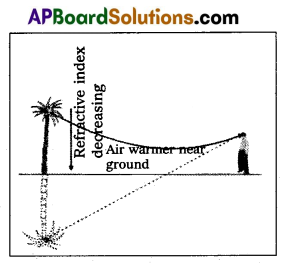
![]()
Question 12.
Define Doppler Effect in light. Explain Red Shift, Blue Shift. What is its importance ?
Answer:
Doppler effect in light : The change in the apparent frequency of light, due to relative motion between source of light and observer. This phenomenon is called Doppler effect.
The apparent frequency of light increases when the distance between observer and source of light is decreasing and the apparent frequency of light’ decreases, if the the distance between source of light and observer increasing.
Doppler shift can be expressed as, \(\frac{\Delta \mathrm{v}}{\mathrm{v}}=\frac{-v_{\text {radical }}}{\mathrm{C}}\)
Applications of Doppler effect in light:
- It is used in measuring the speed of star and speed of galaxies.
- Measuring the speed of rotation of the sand.
Red shift: The apparent increase in wavelength in the middle of the visible region of the spectrum moves towards the red end of the spectrum is called red shift.
Blue shift: When waves are received from a source moving towards the observer, there is an apparent decrease in wavelength, this is called blue shift.
Question 13.
Derive the expression for couple acting on a electric dipole in a uniform electric field.
Answer:
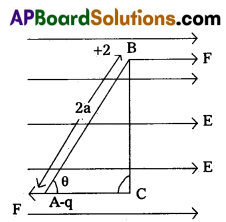
Let us consider two equal and opposite charges -q and +q separated by distance ‘2a’ in an uniform electric field (E). The electric dipole making an angle ’01 to the intensity of electric field (E).
Two forces acting on two charges of an electric dipole. These two forces are same in magnitude but in opposite direction. Hence these forces constitute a torque (or) couple.
From figure, AB = 2a
In Δ ABC, sin θ = \(\frac{\mathrm{BC}}{\mathrm{AB}}\)
⇒ BC = AB sin θ
⇒ BC = 2a sin θ → This is the normal distance between two forces.
∴ Torque = Force × ⊥ ar distance between two forces,
τ = F × 2a sin θ ….. (1)
We know, Intensity of electric field E = \(\frac{F}{q}\)
⇒ F = Eq. ……… (2)
From (1) & (2)
τ = Eq × 2a sin θ
τ = E(2a × q) sin θ
τ = Eq sin θ
(∴ dipole moment, P = 2a × θ)
⇒ τ = \(\overline{\mathbf{E}} \times \overline{\mathbf{P}}\)
Question 14.
Derive the expression for effective capacitance when ‘n’ capacitors are connected in series.
Answer:
Series combination: If a number of capacitors are connected end to end between the fixed points then such combination is called series.
In this combination :
- Charge on each capacitor is equal.
- PD’s across the capacitors is not equal.
Consider three capacitors of capacitances’C1, C2 and C3 are connected in series across a battery of P.D V as shown in figure.
Let ‘Q’ be the charge on each capacitor.
Let V1 V2 and V3 be the P.D’s of three capacitors then
V = V1 + V2 + V3 ………….. (1)
P.D across Ist condenser V1 = \(\frac{\mathrm{Q}}{\mathrm{C}_1}\)
P.D across.IInd condenserV2 = \(\frac{\mathrm{Q}}{\mathrm{C}_2}\)
P.D across IIIrd condenser V3 = \(\frac{\mathrm{Q}}{\mathrm{C}_3}\)
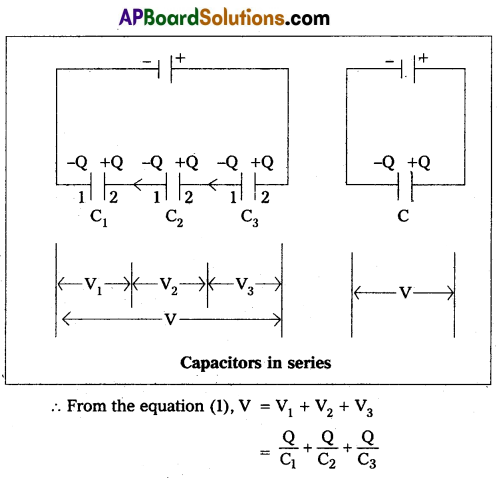
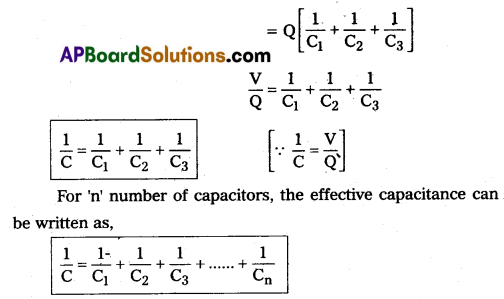
Question 15.
A current of 10 A passes through two very long wires held parallel to each other and separated by a distance of 1 m. What is the force per unit length between them ?
Answer:
i1 = i2 = 10A
r = 1 m
\(\frac{\mathrm{F}}{l}\) = \(\frac{\mu_0 i_1 i_2}{2 \pi r}\) = \(\frac{4 \pi \times 10^{-7} \times 10 \times 10}{2 \pi \times 1}\)
\(\frac{F}{T}\) = 2 × 10-5 N/m.
Question 16.
Define Photoelectric Effect What is the effect of intensity of light on photoelectric current ?. Give one application of photoelectric effect.
Answer:
Photo electric effect : When light of sufficient energy is incident on the photometal surface, electrons are emitted. This phenomenon is called photoelectric effect.
When the intensity (1) of incident light, with frequency greater than the threshold frequency (V > V0 is increased. Then the number of photeelectrons emitted increased then the number of photoelectros emitted increases i.e. the value of photoelectric current (i) increases i.e. i α I.
The effect of potential on photoelectric current:
- On increasing the positive potential on collecting electrode, the photoelectric current increases. At a particular positive potential, the photocurrent becomes maximum which is known as saturated current.
- On increasing the value of negative potential on collecting electrode, the photoelectric current gradually goes on decreasing. As a particular negative potential the value Of photoelectric current becomes zero. This is known as stopping potential.
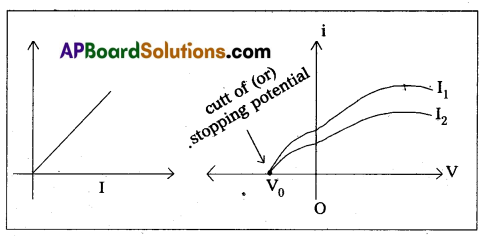
- Stopping potential does not depent on the intensity of incident light. On increasing intensity the value of saturated current increases, whereas the stopping potential . remains unchanged.
![]()
Question 17.
Give two drawbacks of Rutherford Atomic Model. Write any two postulates of Bohr’s Atomic Model.
Answer:
Draw backs : According to classical E.M. theory.
- The revolving electron loses energy continuously, it must spiral inwards and eventually fall into the nucleus. As matter is stable, we cannot expect the atoms to collapse.
- Since the frequency of radiation emitted is the same as the frequency of revolution, the atom should radiate a continuous spectrum, but’what we observe is only a line spectrum.
Basic postulates of Bohr’s theory are :
- The electron revolves round a nucleus is an atom in venous orbits known as stationary orbits. The electrons cannot emit radiation when moving in their own stationary levels.
- The electron can revolve round the nucleus only in allowed orbit whose angular momentum is the integral multiple of h/2π.
i.e., munrn = \(\frac{\mathrm{nh}}{2 \pi}\) ………… (1)
where n = 1, 2, 3, ………. - If an electron jumps from higher energy (Ez) orbit to the lower energy (E1) orbit, the difference of energy is radiated in the form of radiation.
i.e., E = hv = E2 – E1 ⇒ V = \(\frac{E_2-E_1}{h}\) ………… (2)
Question 18.
Explain the working of full wave rectifier with diagram.
Answer:
Rectification : The process of converting an alternating current into a direct current is called rectification. The device used for this purpose is called rectifier.
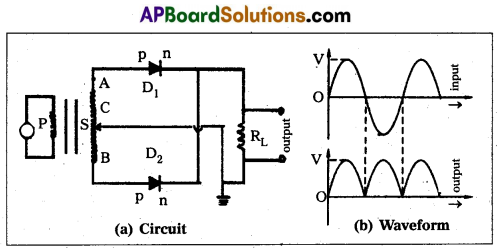
- A full wave rectifier can be .constructed with the help of two diodes D1 and D2.
- The secondary transformer is centre tapped at C and its ends are connected to the P regions of two diodes D1 & D2.
- The output voltage is measured across the load resistance RL.
- During positive half cycles of ac, the diode D1 is forward biased and current flows through the load resistance RL. At this time D2 will be reverse biased andwill be in switch off position.
- During negative half cycles of ac, the diode D2 is forward biased and the current flows through RL. At this time D1 will be reverse biased and will be in switch off position.
- Hence positive output is obtained for all the input ac signals.
The efficiency of a rectifier is defined as the ratio between the output dc power to the input ac power.
η = \(\frac{\mathrm{P}_{\mathrm{dc}}}{\mathrm{P}_{\mathrm{ac}}}=\frac{0.812 \mathrm{R}_{\mathrm{L}}}{\mathrm{r}_1+\mathrm{R}_{\mathrm{L}}}\)
Section – C (2 × 8 = 16)
Note :
- Answer any two of the following questions.
- Each question carries eight marks.
- All are Long Answer Type Questions.
Question 19.
a) How are stationary waves formed in closed pipes ? Explain various modes of vibrations and obtain relations for their frequencies.
Answer:
A pipe which is Closed at one end and opened at the other end is called closed pipe. When a sound wave is sent through a closed pipe, which gets reflected at the closed end of the pipe. Then incident and reflected waves are in same frequency travelling in the opposite directions are superimposed, stationary waves are formed closed.
To form the stationary wave in closed pipe, which has atleast a node at closed end and antinode at open end of the pipe, it is known as first harmonic in closed pipe. Then length of the pipe (l) is equal to one fourth of the wave length.
∴ l = \(\frac{\lambda_1}{4}\) ⇒ λ1 = 4l
If ‘υ1‘ is fundamental frequency then
v1 = \(\frac{v}{\lambda_1}\) where ‘v’ is velocity of sound in air υ1 = \(\frac{\mathrm{v}}{4 l}\) …………… (1)
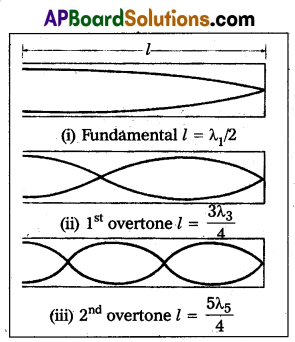
To form the next harmonic in closed pipe, two nodes and two antinodes should be formed. So that there is possible to form third harmonic in closed pipe, since one more node and antinode should be included.
Then length of the pipd is equal to \(\frac{3}{4} \text { th }\) of the wavelength.
∴ l = \(\frac{3 \lambda_3}{4}\) where ‘λ3‘ is wavelength of third harmonic.
λ3 = \(\frac{4 l}{3}\)
If ‘υ3‘ is third harmonic frequency (first overtone)
∴ υ3 \(\frac{\mathrm{v}}{\lambda_3}=\frac{3 \mathrm{v}}{4 l}\)
υ3 = 3υ1 …………….. (2)
Similarly the next overtone in the close pipe is only fifth har-monic it will have three nodes and 3 antinodes between the closed end and open end.
Then length of the pipe is equal to \(\frac{5}{4}\) of wave length (λ5).
∴ l = \(\frac{5 \lambda_5}{4}\) where ‘λ5‘ is wavelength of fifth harmonic.
λ5 = \(\frac{5 l}{5}\)
If ‘υ5‘ is frequency of fifth harmonic (second overtone)
υ5 = \(\frac{\mathrm{v}}{\lambda_5}=\frac{5 \mathrm{v}}{4 l}\)
υ5 = 5υ1
∴ The frequencies of higher harmonics can be determined by using the same procedure.
Therefore from the eq(1), (2) and (3) only odd harmonics are formed.
Therefore the ratio of the frequencies of harmonics in closed pipe can be written.
υ1 : υ3 : υ5 = υ : 3υ: 5υ
υ1 : υ3 : υ5 = 1 : 3 : 5
b) A closed organ pipe 70 cm long is sounded. If the velocity of sound is 331 m/sec. What is the fundamental frequency . of vibration of the air column ?
Solution:
Length, l = 70 cm = 70 × 10-2 m
Velocity of sound, V = 331 m/s
Fundamental frequency in closed pipe,
υ = \(\frac{\mathrm{V}}{4 l}\) = \(\frac{331}{4 \times 70 \times 10^{-2}}\)
\(\frac{331}{280}\) × 102
= 118.2 Hz.
![]()
Question 20.
a) State the working principle of potentiometer. Explain .with the help of a circuit diagram how the emf of two primary cells are compared by using the potentiometer.
Answer:
Working principle of potentiometer: The potential difference across a length of the potentiometer wire is directly proportional to its length (or) when a steady current is passed through a uniform wire, potential drop per unit length or potential gradient is constant.
i.e., ε ∝ l ⇒ ε = Φl where Φ is potential gradient.
Comparing the emf of two cells ε1 and ε2 :
- To compare the emf of two cells of emf ε1 and ε2 with potentiometer is shown in diagram.
- The points marked 1,2, 3 form a two way key.
- Consider first a position of the key where 1 and 3 are connected so that the galvanometer is connected to ε1.
- The Jockey is moved along the wire till at point N1 at a distance l1 from A, there is no deflection in the galvanometer.
Then ε1 ∝ l1 ⇒ ε1 = Φl1 …………. (1) - Similarly, if another emf ε2 is balanced against l2 (AN2),
then ε2 ∝ l2 ⇒ ε2 = Φl2 ……….. (2) - \(\frac{(1)}{(2)}\) ⇒ \(\frac{\varepsilon_1}{\varepsilon_2}=\frac{l_1}{l_2}\)
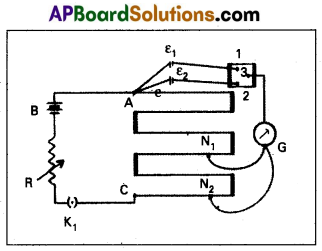
b) Three resistors each of resistance 10 Ω are connected parallel. Calculate the effective resistance of the combination.
Answer:
Here, R1 = R2 = R3 = 10 Ω
In paralled canbination total resistance Rp is given by,
\(\frac{1}{\mathrm{R}_{\mathrm{p}}}\) = \(\frac{1}{\mathrm{R}_1}\) + \(\frac{1}{\mathrm{R}_2}\) + \(\frac{1}{\mathrm{R}_3}\) + \(\frac{1}{10}\) + \(\frac{1}{10}\) = \(\frac{1}{10}\) = \(\frac{3}{10}\)
⇒ Rp = \(\frac{10}{3}\)
![]()
Quetsion 21.
Explain the principle and working of Nuclear Reactor with
the help of a labelled diagram.
Answer:
Principle : A nuclear reactor works on the principle of achieving controlled chain reaction in natural Uranium 238U enriched with 235U, consequently generating large amounts of heat.
A nuclear reactor consists of
1) Fuel
2) Moderator
3) Control rods
4) Radiation shielding
5) Coolant.
1. Fuel and clad: In reactor the nuclear fuel is fabricated in the form of thin and long cylindrical rods. These group of rods treated as a fuel assembly. These rods are surrounded by coolant, which is used to transfer of heat produced in them. A part of the nuclear reactor which use to store the nuclear fuel is called the core of the reactor. Natural uranium, enriched uranidm, plutonium and uranium – 233 are used as nuclear fuels.
2. Moderator : The average energy of neutrons released in fission process is 2 MeV They are used to slow down the velocity of neutrons. Heavy water or graphite are used as moderating materials in reactor.
3. Control Rods : These are used to control the fission rate in reactor by absorbing the neutrons. Cadmium and boron are used as controlling the neutrons, in the form of rods.
4. Shielding : During fission reaction beta and gamma rays are emitted in addition to neutrons. Suitable shielding such as steel, lead, concrete etc are provided around the reactor to absorb and reduce the intensity of radiations to such low levels that do not harm the operating personnel.
5. Coolant: The heat generated in fuel elements is removed by using a suitable coolant to flow around them. The coolants used are water at high pressures, molten sodium etc.

Working : Uranium fuel rods are placed in the aluminium cylinders. The graphite moderator is placed in between the fuel cylinders. To control the number of neutrons, a number of control rods of cadmium or beryllium or boron are placed in the holes of graphite block. When a few 235U nuclei undergo fission fast neutrons are liberated. These neutrons pass through the surrounding graphite moderator and loose their energy to become thermal neutrons. These thermal neutrons are captured by 235U. The heat generated here is used for heating suitable coolants which in turn heat water and produce steam. This steam is made to rotate steam turbine and there by drive a generator of production for electric power,
b) If one microgram of 92U235 is completely destroyed in an atom bomb, how much energy will be released ?
Solution:
Mass, m = 1 μg
= 1 × 10-6 gm
= 10-9 kh
c = 3 × 108 m/s
E = mc2
= 1 × 10-9 × 9 × 1016
= 9 × 107 J.